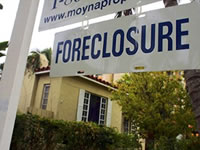Mortgage Modification
Credit Scores
Struggling home owners awarded another $14 billion
by Broderick Perkins
(03/29/2010) With the federal government's year-old housing relief efforts under fire, the Obama Administration recently announced a new $14 billion round of enhancements to reach a larger share of millions of struggling home owners.
The enhancements under the administration's Making Home Affordable initiative, include refinancing for underwater loans, reduced mortgage payments for unemployed homeowners, and pressure to get more lenders to consider reducing the principal of certain mortgages, among other provisions.
Some critics, however, say the enhancements don't go far enough and actually reward lenders for making bad loans that helped bring down the housing market and the economy.
Since its inception early in 2009, Making Home Affordable's mortgage modification segment, the Home Affordable Modification Program (HAMP) has managed mortgage modifications (including trials and permanent modifications) for only 262,000 home owners out of a potential 3 to 4 million eligible home owners.
A mortgage modification, used to make mortgage payments more affordable for struggling homeowners, typically occurs when the lender reworks the terms of an existing home loan by lowering the interest rate and exchanging an adjustable rate for a fixed rate, or extending the term of the loan, or both. Rarely do lenders also reduce the principal to get the payment down, but, thanks to the enhancements, that could be changing.
The refinance segment, the Home Affordable Refinance Program, has reached fewer than 200,000 of the up to 5 million borrowers federal regulators hoped it would help. A refinance, unlike a modification, pays off the old loan with a brand new loan.
Given the small share of needy homeowners actually helped, the Center For Responsible Lending, a critic of results thus far, welcomed the news of the governments enhanced efforts to help home owners.
"We welcome the Administration's stronger actions to stabilize the housing market, particularly doing more to lower loan balances on homes worth less than the mortgage. Foreclosures dragged us into the recession, and until we stop them, the economy will not recover and most homeowners will watch their hard-earned home equity drain away," the Center announced.
Under the $14 billion enhancement, using funds already available from the Troubled Asset Relief Program (TARP) , provisions include:
• More pressure and financial incentives for lenders doing HAMP modifications to offer reduced-principal mortgage modifications and workouts, for homeowners who owe more than their home is worth.
The Bank of America announced a similar plan just days before the Obama Administration announced enhanced relief efforts.
"The core reason principal reductions have suddenly gained traction is the growing recognition that many of the loans in such programs would have represented even larger losses had the properties gone to foreclosure," said Peter Miller, Silver Spring, MD mortgage expert and author of the new eBook "The Quick & Dirty Guide To Mortgage Modifications" (Silver Spring Press, $2.99).
First American Core Logic says more than 11.3 million homeowners are underwater on their mortgages. Current mortgage rates news.
Reducing the principal is crucial to both making a home more affordable and giving home owners incentive to stay in a home that's no longer worth less than the mortgage.
Miller said, "These new programs should be applauded because they save homes and homeowners. First, they're keeping homes out of foreclosure and that's hugely important for families. Second, they're holding down foreclosure inventories. Home prices will not rise until the supply of distressed properties is reduced by 80 or 90 percent in the hard-hit foreclosure areas such as California, Nevada, Florida and Michigan."
• Likewise financial support to lenders who reduce the principal on first and second mortgages, when first mortgages are refinanced through the Federal Housing Administration (FHA). The support includes the additional incentive of insurance coverage to cover lenders' losses on such principal reductions.
• For unemployed home owners, mortgage payments reduced to 31 percent of their previous household income for up to six months while they look for another job. Once employed, homeowners facing a regular payment that's greater than 31 percent will be consider for a permanent HAMP loan modification.
• Up to $3,000 in moving expense paid to home owners entering short sale -- transaction where the lender accepts less than the loan amount to move the loan off the books. That doubles a previous amount offered. Many homeowners who agree to short sales are stuck with bill for the difference between the selling price and the old loan.
Dean Baker, co-director of the Center for Economic and Policy Research in Washington, DC. says the cash incentives approach benefits lenders more than home owners because the incentives are more than the first mortgage holder would collect if the loan went through a foreclosure process.
"By substantially reducing the required payment on the first mortgage, the program will be creating a situation in which the second mortgage-- which would be worth little or nothing in foreclosure-- will suddenly again hold considerable value. This will be a huge windfall for second mortgage holders. It is worth noting that the major banks have vast portfolios of second mortgages," Baker said.
Harp Could Be Music to Homeowners' Ears
Why consumers still balk at buying homes
Government Ramping Up New Short Sale Program

